It’s no surprise that I’m a fan of tone-on-tone color palettes! Whether inside or out, I find using shades of the same color soothing, sophisticated, subtle and harmonious. While there are interiors decorated in this style, it is more challenging to find tone-on-tone gardens – the exception being white gardens which have been popular since the Victorian period. By the way, I have made it a personal goal to visit as many white gardens as possible, so let me know your favorite(s)!
In planning and designing our blue garden, I frequented one of my favorite DC gardens for ideas and inspirations. Located on the grounds of the Washington National Cathedral is the Bishop’s Garden. Designed in the early 20th century by landscape architect Frederick Law Olmsted, Jr. and Florence Brown Bratenahl, wife of the second Dean of the Cathedral, this hillside garden is a gem worth exploring.
Inside the high stone wall are herb gardens, perennial borders and beds, a rose garden, a folly (the Shadow House), an expansive lawn, and medieval sculptures and architectural relics. These include a 9th century baptismal font supposedly from the Abbey of St. Julie in the Aisne, 12th century Norman stone arch, 15th century bas-relief plaques, etc.
I recently met with a client at the Bishop’s Garden to discuss designs for her blue garden. Enjoy these photos from mid May.
With the majestic cathedral as a backdrop and sounds of church bells ringing, the Bishop’s Garden is truly spectacular.
The lower perennial garden beds are known as the blue borders. Next to the blue-gray stone walls, the predominately cool colored flowers create a layered tone-on-tone effect.
A stunning color field of blues, lavenders, purples and whites. Above are Baptisias. Below are Salvias (front left) and Siberian Irises (front right).
A close up of Siberians – so pretty and delicate!
Help! Can you help identify the above? My client and I both want this plant. UPDATE: I just learned that is an Anchusa. Many thanks to
Monica and
Rosemary!
Located on the south side of a hill, the blue borders get full sun and excellent drainage. Once again, I took these photos in mid May. The borders are equally lovely at the height of summer when Agastaches, Buddleias, Lavenders and Russian Sages are in full bloom.
Here are the beautiful lavender-blue blooms of Nepetas.
I love the royal blue color and feathery foliage of these Larkspurs, which are related to Delphiniums. I cannot grow Delphiniums successfully with our very hot and muggy summers so perhaps I’ll give Larkspurs a try. Thank you again to
Rosemary for helping me identify these beauties!
Aquilegias and Nepetas spilling over. Notice the repetition in color and plantings, both of which I practice in my designs.
This charming folly is known as the Shadow House. Doesn’t the setting remind you of the Cotswolds in England?
Just as important as flowers, foliage in a tone-on-tone garden should be carefully chosen. I find silvery and gray foliage, such as the Lamb’s Ears above, complement a blue garden perfectly.
Icy blue flowers and wispy foliage make Amsonias must-haves in the blue garden. Behind is a 15th century carved stone bas-relief of St. Catherine and martyrs.
Punctuating the borders in mid May were many purple Alliums.
Not all the gardens at the National Cathedral are blue themed. In the Hortulus (little garden), the perennials and culinary and medicinal herbs are all inspired by plantings documented in a 9th century monastery. At the center is the French Carolingian baptismal font dating to Charlemagne’s time.
Nearby is this 18th century English bronze sundial sitting on a 13th century Gothic capital of carved limestone from a ruined monastery near Reims, France.
I hope you have enjoyed this tour. To read more about the Bishop’s Garden, visit
here. And if you know of a blue or white garden, please share. Thanks!
Loi


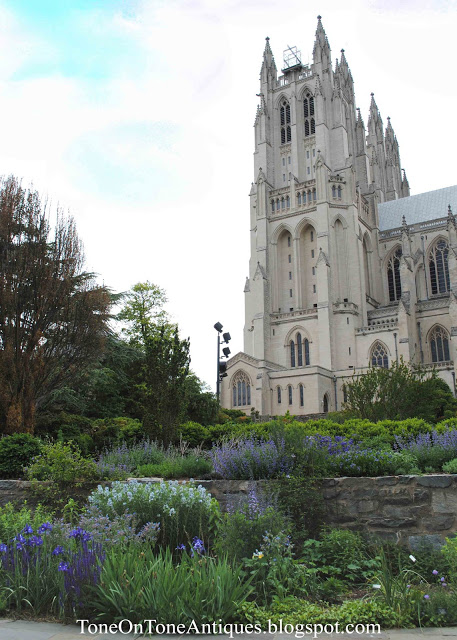
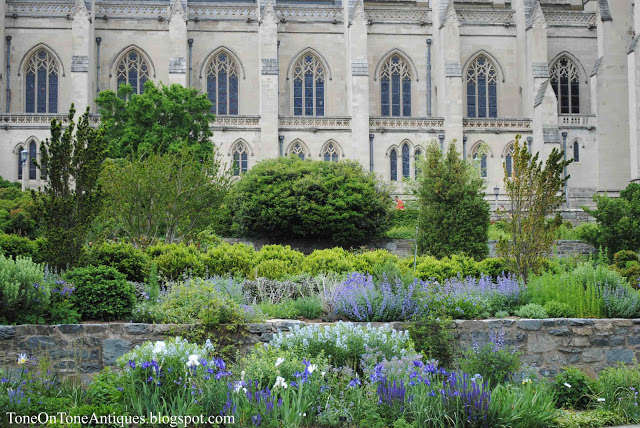
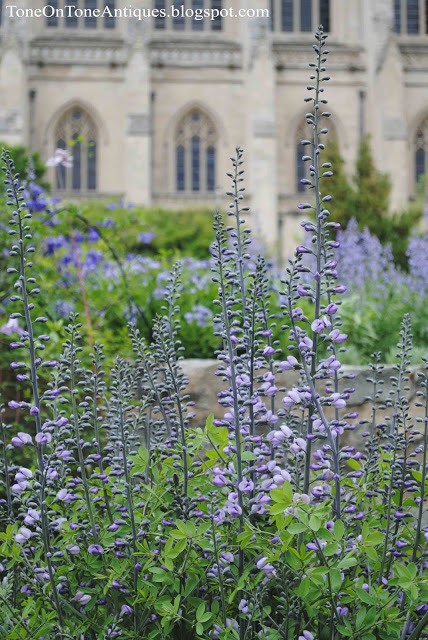
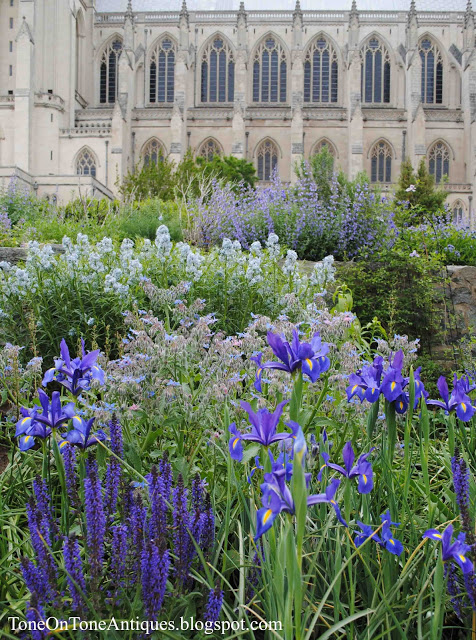
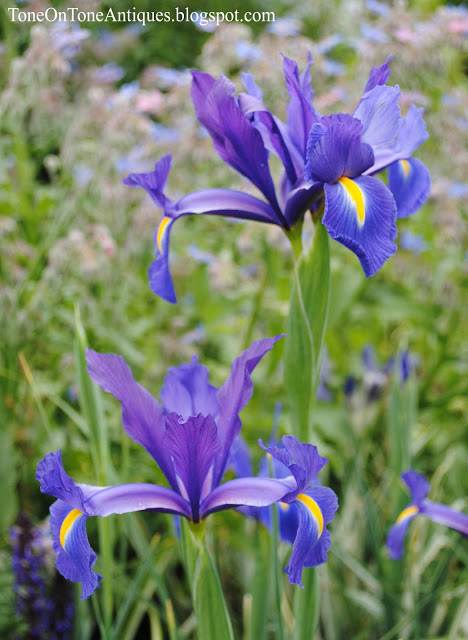
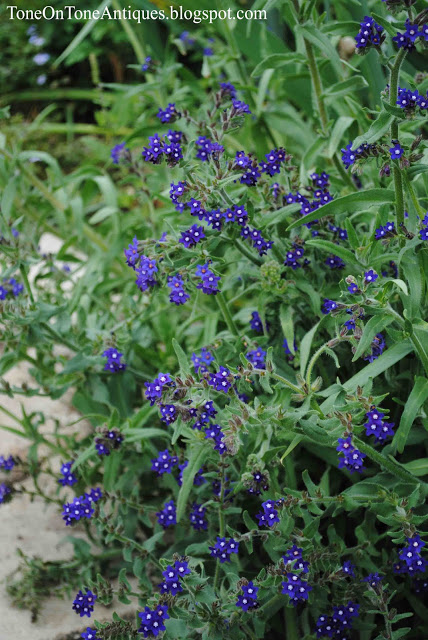
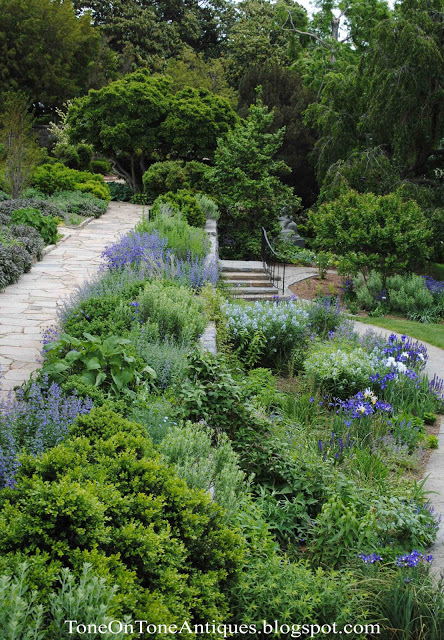
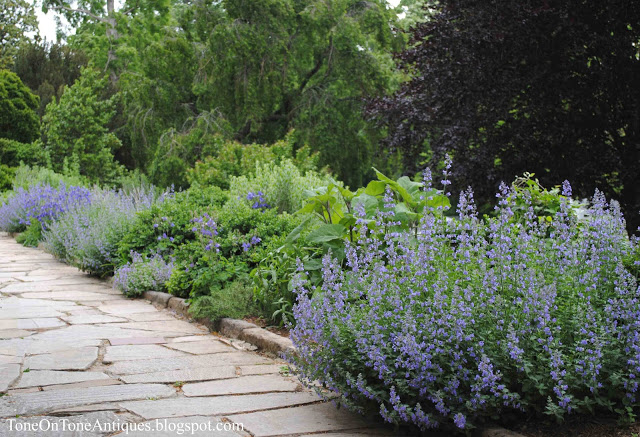
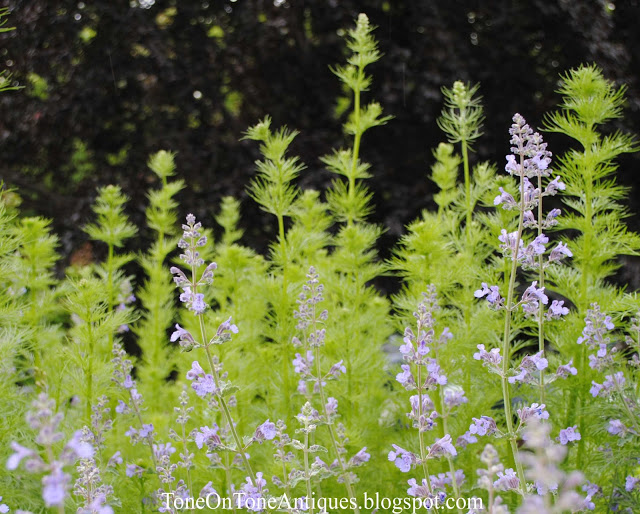
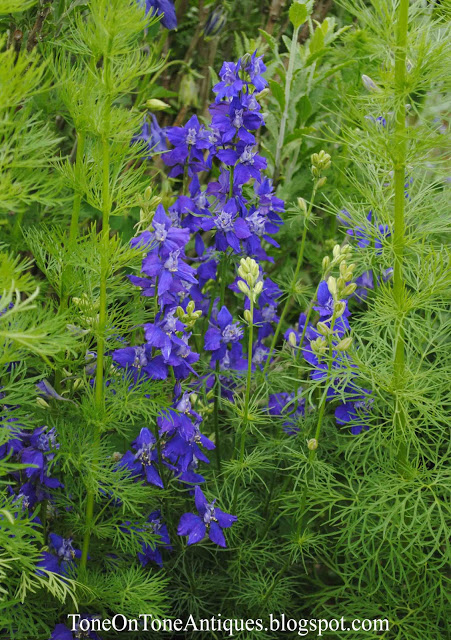
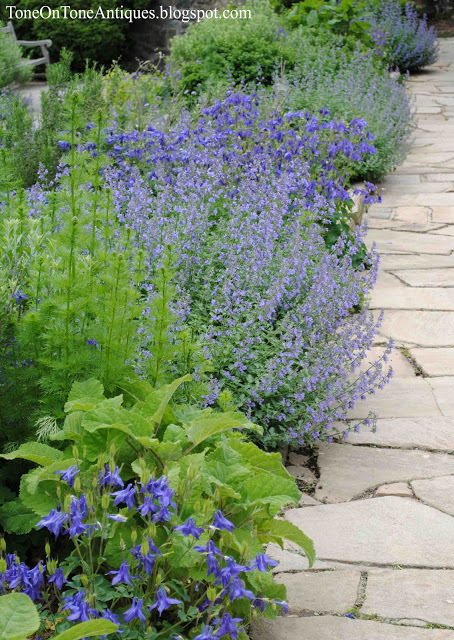
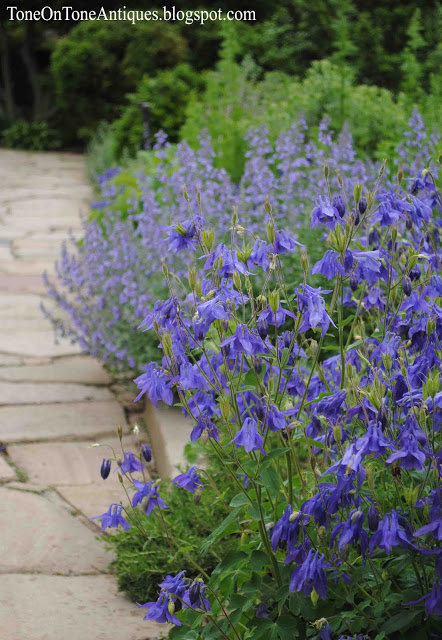
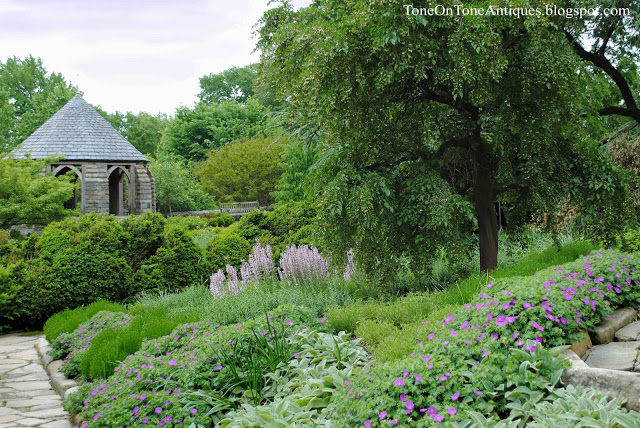
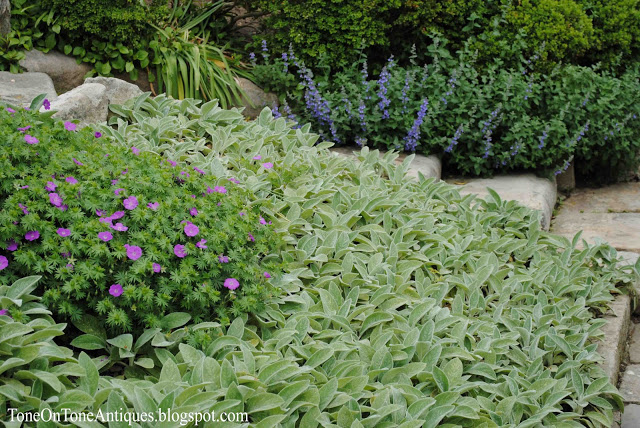
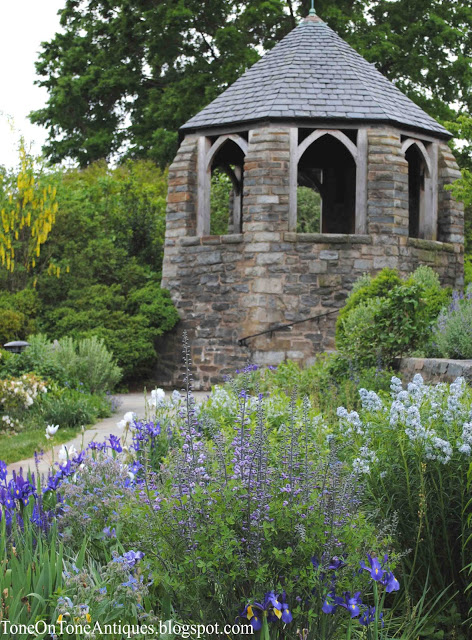
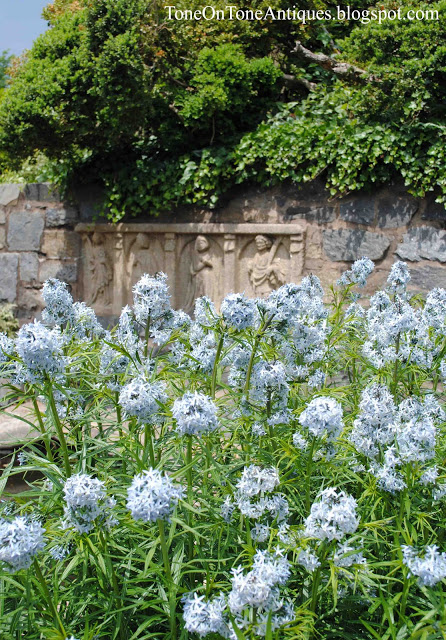
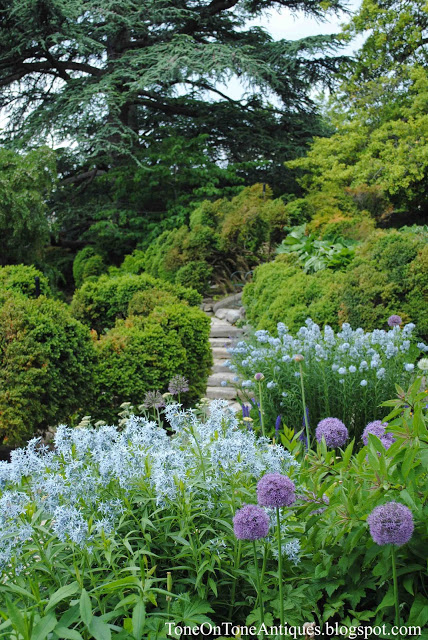
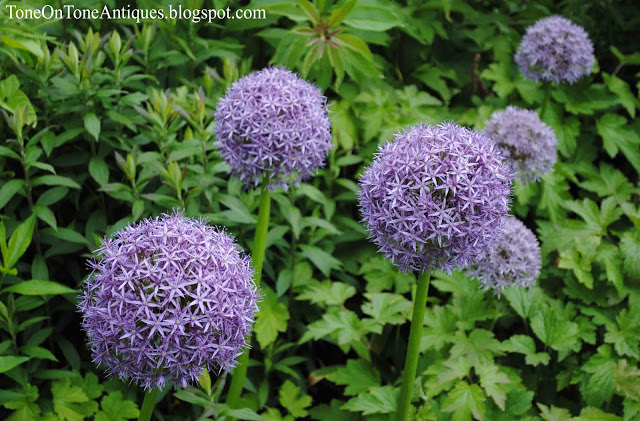
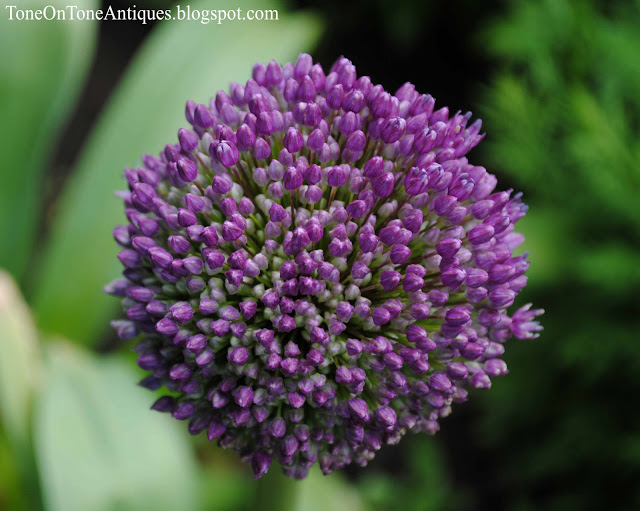
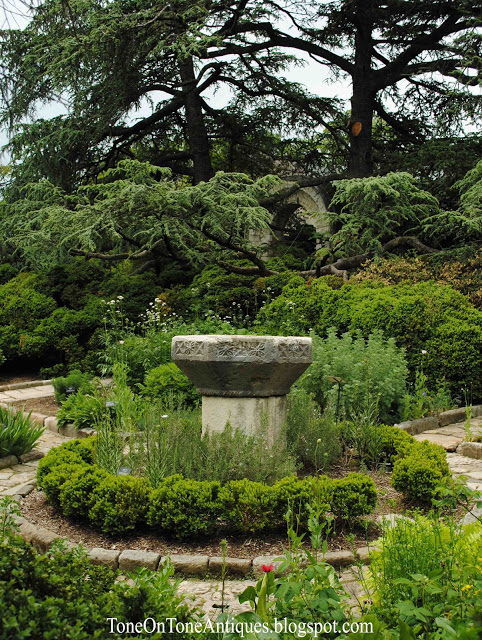
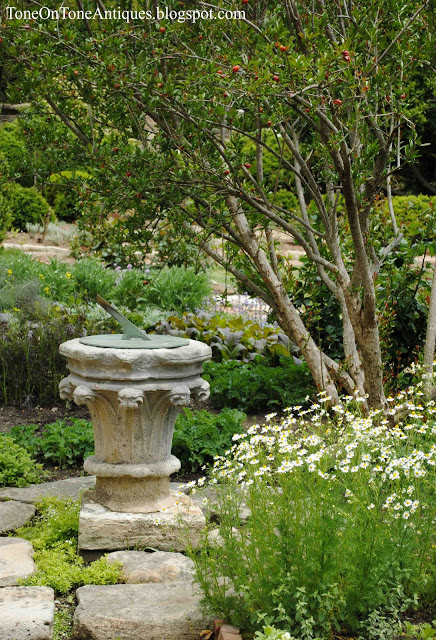
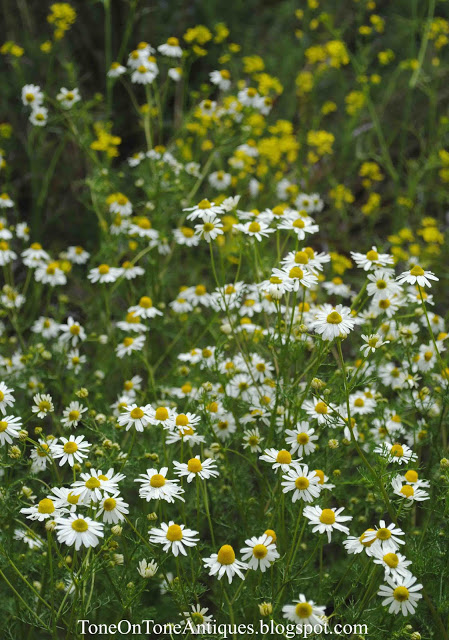
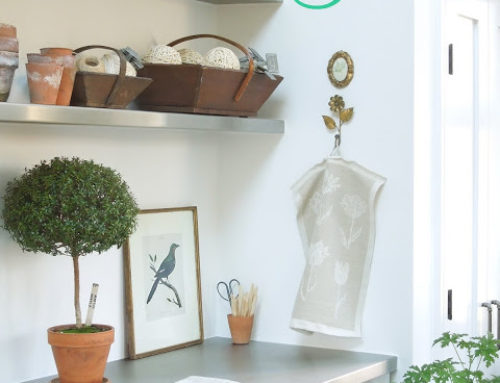
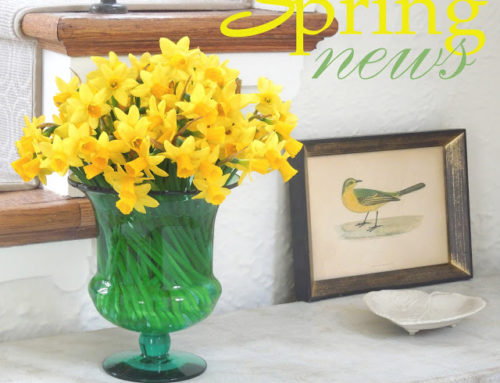
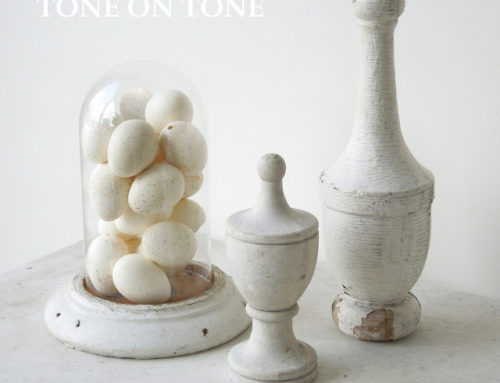
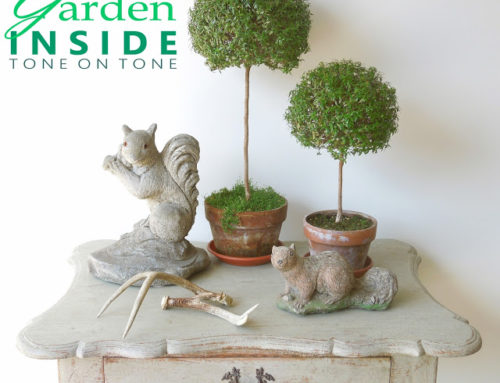
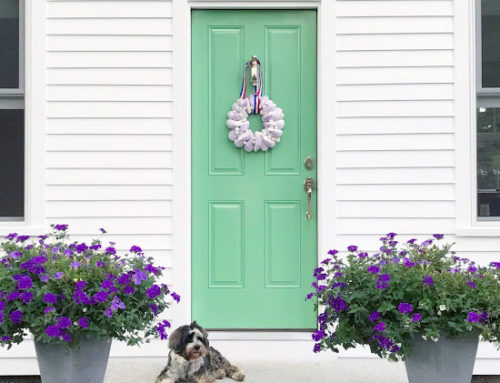
it's all so beautiful! love the color and love the allium. how great to be able to visit easily!
Loi, the Washington cathedral and its gardens are spectacular. That is one of my favorite places to visit. Strangely I do not think I ever noticed it was. Blue garden. I think your new garden is going to be beautiful.
As for gardens, do you follow Juniper Hill Farms? Jim has a spectacular garden in NH and his knowledge of plants is like an encylopedia.
I know of a few others but at this minute they escape me.
Have a great week Loi, and thank you for always bringing so much beauty to the world.
Elizabeth
Thanks for sharing, Elizabeth! I'll look up Juniper Hill Farms!! Take care, Loi
Loi…I admire your attention to details….all of these gardens are beautiful!
Lovely garden eye candy! I fluctuate between color or no color..especially since Gibbs seems to be snacking on everything planted in our pool yard. I want to fill in all my blank spaces in beds with blue.. what holds up to our August heat? anything?? After a day like today my young tomatoe plants go badly burned…and it's still May. I love your tour and taking me places I don't go. Thanks buddy. Hope all is well.
xoxoxNancy
Powellbrowerhome.com
Gibbs is growing sooooo fast! Nancy, try Salvia Black and Blue. It loves the heat, and is a prolific bloomer in our garden.
I would love a blue garden! This year I went all over creation to find blue lobelia for my containers.
Hi Loi! Thanks for the tour! I do adore blue flowers, especially delphinium.
I believe your mystery plant is summer forget-me-not (anchusa)
http://plantselect.org/2012/05/summer-forget-me-not-anchusa/
Although at first I thought it may be blue flax, or Georgia Blue Speedwell.
Hope this helps!
Thank you SO much, my friend! I hope it is cooler for you all. Mid 90s in DC this week.
As stated above, your attention to detail is phenomenal and is one of the main reasons I love your blog so much! The most important reason being that you are such a dear, loving, wonderful individual with excellent design skills! Thank you so much for sharing this with us! It is truly breathtaking!
Loi,
This was just a smile-inducing tour! What a little gem of a garden. So happy to know about it for my next trip to D.C. I'm sure you and your client came away dazzled, delighted and inspired!!!
And…Alliums are one of my favorite flowers. They just scream HAPPY!
xoxo Elizabeth
The Bishop's Garden at the National Cathedral is gorgeous. We have visited the grand Cathedral many years ago and I remember how big it is inside. I would like all of those gorgeous flowers in my garden too. So beautiful!
Your camera has captured a masterpiece in Blues! I have never seen anything so beautiful. Thank you for sharing this. Truly your love and passion for gardens comes through the lens.
Once again you've inspired me with your gorgeous pictures to create something new! I will have to find a spot to create an all blue garden…my husband will be so happy! 😉 I haven't been to the gardens at the National Cathedral, but clearly I need to because they truly are beautiful. And I love delphinium, but we have way too much sun and heat at this house to be able to successfully grow them…sadly the same is true for sweet peas.
xo Kat
Loi, I love these gardens, the chosen flowers are perfect for the varieties of blues, the lambs ears always a favorite foliage. Then the Baptismal Font, the Folly, and sundial. You instantly lower my stress and elevate my state of being!
xoxo
Karena
Art by Karena
Fantastic, I love the dedication to blue, which is a less common color in the garden. I also love my new list of blue flowers I can incorporate in mine. Great post, unique information and perspective, love it! ~ebh
Hello Loi, Blue flowers bring the color of the sky down to the garden level, and integrate the two. Your pictures also recall Rosemary's recent post about the bluebells scattered through the woods.
Some of my favorite wildflowers are blue. Wild lobelia are always a treat to come across, but perhaps my favorite blue flower is the simple and friendly chicory found by every roadside.
Dear Loi,
I love the photographs you have taken mon ami!
I have just been reading Madelief's blog about her own white garden: http://madeliefje-madelief.blogspot.de/2013/05/the-almost-white-garden.html and then there is the white garden at Sissinghurst.
I think that i avery pretty flower that (if I am not mistaken) is sometimes white and sometimes pale blue, is the Quaker Ladies. It always looks like such a simple flower.
I think that I must go to Washington DC one day.
Bye for now
Kirk
PS
Delphiniums are such a lovely flower aren't they.
Kirk – Thanks for sharing Madelief's site. I'll check it out soon. And I'm not familiar with Quaker Ladies. Thanks for that, too 🙂 Hope you and AGA are well!!
The Bishops garden is blue heaven – glorious.
The flower you call a Delphinium I think is a Larkspur – same family genus but with feathery leaves and thinner stalks enabling it to survive better in the heat.
The other plant is a member of the Borage family – Cape forget-me-not, Anchusa. The one you show is probably Anchusa capensis Blue Bird which has indigo coloured flowers – they come in various shades of blue.
I agree that perhaps that is larkspur due to its leaves Loi.
Hi, Rosemary and Monica – You all are the best! Thanks for identifying my mystery flowers!! I added the info in my post.
First of all I admire your bright, well focused photos, they are perfect Loi. This is my first delight since I've started to visit your blog. This is a real treat and attraction. So, the garden tour is stunningly sublime and it must be very unusual to find blue or white gardens and to combine plants with textures and colors.i have in mind Monet's garden at Givergny with blue iris, mauve wisteria and of course it's beautiful blue -hued lily ponds.
I know I say this all the time, but it's true: My heart skips several beats when I open your page, LOI!!!!!!!
You and I (as I'm sure many others who come to see you) share the same love for TONE ON TONE. You describe this style well as being calm, sophisticated and harmonious. But if there is a COLOR outside of this palate that I would have (and do), it is blue/lavender/aqua/cobalt. I don't even know where to begin here, but basically, the tone on tone is a perfect all-year-round backdrop for just about ANY color you wish to splash on for effect. For me, it's these hues of the blues during summer. I have all white flowers in my pots this year against the incredible lush green of all my boxwoods. I am in heaven. But on my balcony, I have purple lobelia, and I also plan to plant some russian sage in the front. I also have a rather old bunch of dried lavender in an urn on my deck that the wind stirs up and gives me the lavender scent I live by. I enjoy watercolouring or reading on my deck with an occasional whiff of France.
You my friend, you really know how to stir the senses. ENJOY and I loved the link to your BLUE GARDEN. BE WELL, you two! Anita
Loi,
Blue gardens are so beautiful and this one is certainly one of the prettiest I have seen (through your eyes, thank you)! My favorite- the Siberian Irises.
Best,
Mimi
I could tour gardens all day long. This was lovely, but my favorite is your white garden.
Hi, Loi,
Thanks for bringing back so many fond memories of the National Cathedral's gardens; I've spent a lot of time there and remember especially the wonderful smell of boxwood.
the most perfect compliment to the grey stone. I just loved browsing these photos and can hardly wait for my blue garden to grow this year!
Love it!! I like to use blues and white in my gardens because of the coolness they make you feel. I do add a pop of pink for a happy feeling, but the base is blue and whites. You are right it is hard to find plants that bloom in blue, but when you do it is so gratifying. Thanks for this lovely garden tour, always a pleasure to see it through your eyes,
happy Thursday,
Kathysue
love this tour and your photos which capture the essence of this sacred place. blue is so easy for me to love, and i love the harmony when it meets white's melody. i will keep an eye open for a blue garden now to share. i will be playing in the dirt today again (yesterday brought so much peace doing just that).
smiles.
michele
I loved getting to see all of this! How interesting and beautiful! All of your photos would make the loveliest coffee table book. Actually I can imagine at least two different books. And I'd want them both!!
Loi,
I've made a list, I must try some of these plants. Besides white, my favorite color in the garden is blue. I've planted delphiniums every year, along with lavender and a hardy geranium 'Johnson's Blue' but I don't have room for some of the striking examples you've shared. I'm thrilled to visit the gardens with you (virtual tours)!
Karen
I have been to a service at the cathedral, use to know the head guy there. Adore the purple Alliums, hmmm never see them in S. CA except at the flower market. If you haven't been to flower gardens at La Dew beautiful setting just outside Baltimore in Monkton, MD.GO. I did a shoot there once. Amazing! Grand Post as always. xxpeggybraswelldesign.com
Loi, this is so pretty with the different shades of blue that just keep carrying your eye on. Thanks for sharing these beautiful gardens.
Yes indeed… Delphinium are so hard to grow down here; I had gorgeous plants up in the Hudson Valley! Have you tried Larkspur? It has the same color family and almost (not quite..) looks like Delphinium and loves this heat! I haven't had luck with the seeds, but many of my neighbors have beautiful blue gardens with it.
Hi, Libby – Thanks to you all, I'm going shopping for Larkspurs this weekend. Hope the weather cools a lot! 🙂
What a delightful post!! I still have to visit the National Cathedral. We drove past it!! I didn't know their garden was so gorgeous. I don't have luck with delphiniums either. They grow tall and bloom well here but then they look really bedraggled and moth eaten. I am taking mine out after this year!! I love that you have such impeccable taste and style. You are an old soul Loi!!
I just found an amazing garden blog by a landscape architect in DC. I have been meaning to send you the name as I just started reading myself.
I saw a Frederick Law Olmsted exhibit in Montreal years ago. What a craft.
Xo Terri
Thanks for the beautiful pictures and for another local garden to add to my "must visit" list since I'm in Northern Virginia. I am in the same area as you so can't grow delphiniums, either, but I agree with the others that the flowers you labeled delphiniums above look more like annual larkspur to me (Consolida ajacis) based on the ferny foliage, and it can be grown here from seed, and it often even reseeds itself. It is done by mid-summer, though.
Beautiful Loi!…….When it comes to 'White Gardens' then it has to be Sissinghurst Castle which is just one mile down the road from us in Kent…..the stunning world renowned garden designed by Vita Sackville West.
Have a lovely end of week, Sophia x
Gorgeous tour! It has me dreaming beyond the capabilities of my zone 3 garden 🙂
Stunning images- no doubt your take will be just as captivating! Just scrolled down to catch-up a bit-CONGRATS on the SL feature. They were my first magazine and still one of my favorites and just keep getting better and better! thankfully I am a subscriber so I miss it!
xo,
~R
I love a blue garden! I used to have one years ago and thought it was so refreshing during the hottest Summer days. Thank you for the wonderful tour, you've given me some ideas 😉
Hi Loi, you can guess I loved this! Just spent the entire day in the garden…it got pretty hot out there…Blue has a coolness which works well in my shade garden, I admire the examples here…so gorgeous. Lavender is also my favourite colour with white. This year I found Spanish lavender, not edible, which I just love…putting it in some outdoor urns under planted with oregano…we shall see! Thank you for sharing another beauty…N.xo
Truly lovely! I wish you could come create a garden for me – you really have a great eye for design and wonderful plants!
Lovely post Loi. Blue gardens are my favorite! They compliment the deep green and the gray stone perfectly. The blue gardens tend to be a bit more deer resistant here in PB too.
Visiting a local flower farm down the street from the country place this weekend-I'll be thinking of you :)!
Hugs,
Sarah
Loi,
I love this blue garden. It is beautiful. I also saw a few photos of some new blue plants I will have to try to add to my garden. Your photographs are spectacular! Thanks for sharing this visit. I will have to add this to my list of gardens to visit most definitely!
Susan
oxoxo
Hi Loi,
Thank you for introducing me to this exceptional garden! I've never seen such a wide selection of blues growing so happily together. It is really impressive, not just the color, but the artful contrasting of leaf types. Their head gardener is a master.
I love blues in any garden – mixed or straight-up! My favorite blue plant(down here in Texas zone 8)is Mealycup Sage. Mine are putting on a lovely show. They have silvery leaves and the most intense blue flowers. Perhaps they would thrive in your area – I think you are zone 7?
Best wishes as always, Suzanne
Hello Loi
Thanks for the wonderful tour of the Bishop's Garden. The blue is spectacular and so many shades of this colour make is possible. I had a small area of my garden which was white. It was at our farmhouse and beside were 6 acres all organic – the amount of visiting non white plants and flowers finally won out.
Hope your weekend is special
Helen x
Good morning Loi! I just wandered over to see your magnificent eye capture all that is sublime. What perfection.
Have a super day! Anita
Hi Loi! Wow..lots to look at today and the timing is perfect as I'm off today and plan to get some gardening done. Our climate creates a jungle and it's overwhelming at times. Plants are dormant and then.. surprise! They grow out of control! I will review this post with my husband, it's gorgeous and filled with ideas. I love the layering (tone-on-tone;) that you are showing. The purple Alliums are so cute aren't they? I like to see them pop up from the otherwise green landscape that is so common here. Thanks for sharing your expertise with us and have a wonderful weekend! xxleslie
Love this post! I'm also a big fan of tone on tone – monochromatic themes. You do them so well, Loi.
I thought the mystery plant was a verbena – like this one http://www.danziger.co.il/index.php?page_id=2437
but it might be a smaller plant with a similar flower.
Thanks for sharing the names of these plants, it's good to have them for future reference.
-Revi
Lord Loi you have stopped me in my tracks today with this beautiful, beautiful posting. Your photographs are stunning and I would happily hand you my magic trowel and give you carte bleu in creating an azure garden for me.
Such beautiful images. I noticed that anchusas are for sale at Annie's Annuals, a mail order ( and retail) nursery. Love your blog!
In a word – Stunning! The first photo looks like a book cover and the subsequent pages would happily sit on my coffee table! Please publish! Love blue in the garden and white, well, that goes without saying! Just beautiful, Monica
Hi Loi,
It's all so breathtakingly beautiful! These blue hued lovelies are deeply dramatic but also playful and sweet – case in point: Salvias and Siberian irises and anchusas, respectively. The lavender tones in the fields, surrounding the cathedral are truly heavenly! Thank you for this gorgeous introduction to The Bishop's Garden.
Poppy
Loi, I love your garden posts always! This one is lovely. The last time I was in D.C. I was a teenager and not interested in gardens then. I'm sure I missed so much that I would happily gobble up now!
Cheers,
Keri
Hi Loi, What a beautiful place and post. It is hard for me to believe that in all my time in DC I never saw this – thank you for the tour. Baptisia have always been a favorite, I had them in the garden at our previous house; I will have to find a place for them here – where I have yet to plant a garden. I'm getting there!
xo,
Phyllis
That is definitely the look I tried to go for in my garden and it seems that many of the blue/lavender flowers seem to not interest the Deer!
WHat gorgeous images as usual my friend!
xo Karolyn
Loi, I meant to leave this in my comment yesterday, although I am sure that you know of Paul Gervaise and his beautiful garden and house in Lucca Italy. Here is the link to his blog: http://gervaisdebedee.blogspot.com/2013/05/lucca-antiques.html and webpage. http://www.paulgervais.com/
Have a great weekend!
Dear Loi this garden is relly spectacular! Thank you so much for showing to us!!!
I have made again your blue garden's tour, and every time I remain breathless between all this beauty. I wish you have been closer to me to help me creating my garden, now… I have so many doubts… =)
Hugs and have a nice WE my friend
Silvia
Beautiful. I especially like the blue irises. And your photos are amazing, Loi.
Claudia
Be still my beating heart! I must visit these gardens someday! I just adore every photo! I'll be back to look at these pictures again and again!
Delphinium and Lamb's Ear and Allium, oh my! What a perfect place to find some color inspiration.
Love single shade flower gardens and this blue is spectacular. Amsonias are a definite for next year. Thanks for sharing, Loi. Always an inspiration.
Have you been to Ninfa outside of Rome? Supposed to be one of the most beautiful rose gardens set in the ruins of a castle. As I recall most of the rose blossoms were white or pale, pale pink.
b
Absolutely stunning! Love the Baptista (false indigo).
What a beautiful tour, Loi and a garden that I must visit the next time I am in Washington. Your own gardens are so beautiful that I'd love to visit the too!!
My dear Loi! HELLO!
Thank you for coming to visit my house/garden post! I am always striving to get the look YOU emulate in your design, and yet we still have so much to do. But you saw what we had to work with and it gets better all the time. If I had my druthers, I would have pavers in the garden to give things a tidier look, but for now we stay with the gravel. Next project is putting up the gray exposed beams in the new addition (not shown on my post) and then we're done…for now! NOT the end!
Hugs, Anita
Right near Anita! I know she appreciates stunning gardens like this…
Dear Loi….this is such an exquisite place…..regally beautiful, yet so serene….
Thank you so much for sharing this as well as the history.
I really don't know of any white gardens around this area, and truth be told, I have only learned of tone-on-tone gardens from you and Anita!! I just love this design concept, and now I will be on the lookout….
Have a fantastic week, sweet friend! Thank you for the beauty….
Hugs,
– Irina
Beautiful, but when I saw these blue beds here, I went back to a blog post I did two years ago on the Bishop's garden, and they were quite multi-colored. I wonder if they have re-designed the plantings this year, or if the cool spring has just favored the blue-flowered plants.
I visited the garden in April and was sorry to see that the cherry trees (I think they were cherries) that shaded the entrance had been removed (maybe victims of Sandy?).
http://enclosuretakerefuge.com/2011/06/28/antique-shades-of-green-the-bishops-garden/
Aside from white/green gardens, Blue would be my next favorite. Blues are always so soothing and cooling in a garden. Thanks for taking us along on the stroll through this lovely garden.
xo
Terri
shutup, just shutup!!! nothing more beautiful on this good earth than a blue garden. (except maybe one of your white gardens!) xo
Loi,
Gorgeous! Thank you for the inspiration. I am working on my garden now and so would like to stick to a blue and white theme.. I just have a hard time passing up the pinks!
Christina
Loi I love a garden of various shades of blues and white. There are more varieties than on would think!
This garden is gorgeous!
xoxo
Karena
2013 Designer Series